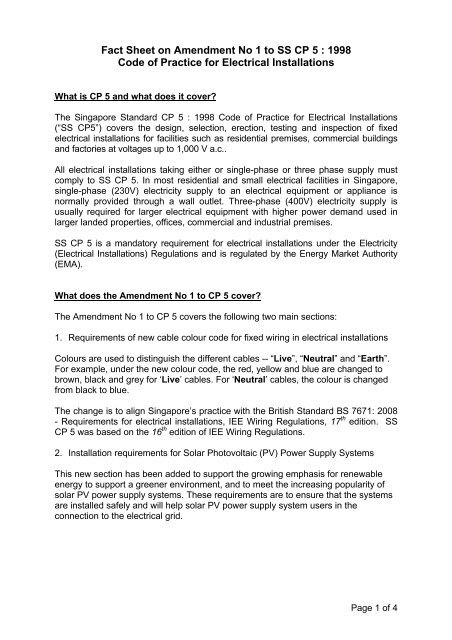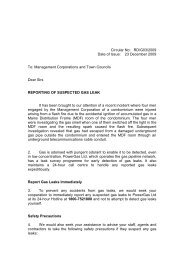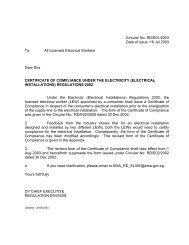Code of Practice for Electrical Installations
CP5-Amd 1_27-Feb-2009- Fact-Sheet.pdf - EMA Elise - Energy ...
CP5-Amd 1_27-Feb-2009- Fact-Sheet.pdf - EMA Elise - Energy ...
Create successful ePaper yourself
Turn your PDF publications into a flip-book with our unique Google optimized e-Paper software.
Fact Sheet on Amendment No 1 to SS CP 5 : 1998<br />
<strong>Code</strong> <strong>of</strong> <strong>Practice</strong> <strong>for</strong> <strong>Electrical</strong> <strong>Installations</strong><br />
What is CP 5 and what does it cover?<br />
The Singapore Standard CP 5 : 1998 <strong>Code</strong> <strong>of</strong> <strong>Practice</strong> <strong>for</strong> <strong>Electrical</strong> <strong>Installations</strong><br />
(“SS CP5”) covers the design, selection, erection, testing and inspection <strong>of</strong> fixed<br />
electrical installations <strong>for</strong> facilities such as residential premises, commercial buildings<br />
and factories at voltages up to 1,000 V a.c..<br />
All electrical installations taking either or single-phase or three phase supply must<br />
comply to SS CP 5. In most residential and small electrical facilities in Singapore,<br />
single-phase (230V) electricity supply to an electrical equipment or appliance is<br />
normally provided through a wall outlet. Three-phase (400V) electricity supply is<br />
usually required <strong>for</strong> larger electrical equipment with higher power demand used in<br />
larger landed properties, <strong>of</strong>fices, commercial and industrial premises.<br />
SS CP 5 is a mandatory requirement <strong>for</strong> electrical installations under the Electricity<br />
(<strong>Electrical</strong> <strong>Installations</strong>) Regulations and is regulated by the Energy Market Authority<br />
(EMA).<br />
What does the Amendment No 1 to CP 5 cover?<br />
The Amendment No 1 to CP 5 covers the following two main sections:<br />
1. Requirements <strong>of</strong> new cable colour code <strong>for</strong> fixed wiring in electrical installations<br />
Colours are used to distinguish the different cables -- “Live”, “Neutral” and “Earth”.<br />
For example, under the new colour code, the red, yellow and blue are changed to<br />
brown, black and grey <strong>for</strong> ‘Live’ cables. For ‘Neutral’ cables, the colour is changed<br />
from black to blue.<br />
The change is to align Singapore’s practice with the British Standard BS 7671: 2008<br />
- Requirements <strong>for</strong> electrical installations, IEE Wiring Regulations, 17 th edition. SS<br />
CP 5 was based on the 16 th edition <strong>of</strong> IEE Wiring Regulations.<br />
2. Installation requirements <strong>for</strong> Solar Photovoltaic (PV) Power Supply Systems<br />
This new section has been added to support the growing emphasis <strong>for</strong> renewable<br />
energy to support a greener environment, and to meet the increasing popularity <strong>of</strong><br />
solar PV power supply systems. These requirements are to ensure that the systems<br />
are installed safely and will help solar PV power supply system users in the<br />
connection to the electrical grid.<br />
Page 1 <strong>of</strong> 4
What is the current cable colour code?<br />
What is the new cable colour code?<br />
From 1 March 2009, the new colour cables may be used <strong>for</strong> all new fixed electrical<br />
installations, including the addition and alteration <strong>of</strong> electrical wiring to existing fixed<br />
electrical installations.<br />
From 1 March 2011, only the new colour cables are allowed to be used.<br />
Page 2 <strong>of</strong> 4
What should the public do?<br />
There is no need to rewire existing fixed electrical installations.<br />
The public has to be aware <strong>of</strong> the colour code change <strong>for</strong> the fixed electrical<br />
installations and that new electrical appliances are already aligned to the new colour<br />
code.<br />
When new cable colour code is used <strong>for</strong> the new circuits that are added to existing<br />
electrical installations, the Licensed <strong>Electrical</strong> Worker (LEW) will have to do the<br />
necessary colour marking on the cables and also place a caution notice (shown<br />
below) on the relevant distribution boards.<br />
CAUTION<br />
This installation has wiring colours to two versions <strong>of</strong> <strong>Code</strong> <strong>of</strong><br />
practice <strong>for</strong> electrical installations (CP 5).<br />
Great care should be taken be<strong>for</strong>e undertaking extension,<br />
alteration or repair that all conductors are correctly identified.<br />
What is the transition period?<br />
SS CP 5 Amendment No. 1 is effective from 1 March 2009.<br />
A transition period <strong>of</strong> two years is given <strong>for</strong> the change to the new colour code.<br />
During this period, both new and existing colour cables may be used <strong>for</strong> fixed<br />
electrical installations.<br />
From 1 March 2011, only the new colour cables are allowed <strong>for</strong> use in new electrical<br />
installations and electrical additions and alteration works.<br />
Why is Amendment No 1 to CP 5 important?<br />
1. Aligning Singapore’s requirements to international practices and meeting<br />
renewable energy needs<br />
The adoption <strong>of</strong> the new cable colour code will align Singapore’s practices to<br />
international practices. The British standard, which the Singapore’s standard is<br />
aligned to, has revised and standardised its cable colours with the EU according to<br />
the new code. Other countries in the Middle East and Hong Kong have also<br />
implemented the change in the cable colours.<br />
In addition, the implementation <strong>of</strong> the installation requirements <strong>of</strong> PV supply systems<br />
will widely promote the use <strong>of</strong> renewable energy in Singapore and standardise the<br />
installation practices. This will help Singapore grow its clean technology industry and<br />
achieve its climate change goals.<br />
Page 3 <strong>of</strong> 4
2. Enhances competitiveness <strong>of</strong> enterprises<br />
Singapore relies substantially on cable imports. To ensure a steady supply <strong>of</strong> cables<br />
at competitive prices, it is necessary to adopt the new cable colour code which many<br />
major countries have adopted. As less countries use the existing colour code,<br />
abiding to it may result in a shortage ultimately, causing higher prices <strong>for</strong> the existing<br />
colour cables. The change will help local businesses safeguard against price<br />
fluctuations and delivery delays, thus enhancing competitiveness.<br />
Solar PV power supply systems are becoming more popular in Singapore with<br />
worldwide concerns over the sustainability <strong>of</strong> fossil fuels. Standardisation and<br />
compliance to installation requirements will help ensure consistency <strong>of</strong> practices<br />
locally. This will ensure that local companies can install the systems safely and also<br />
enable them to service both local and overseas customers.<br />
Who uses Amendment No 1 to SS CP 5?<br />
This amendment will be used by contractors, consultants, installers and the<br />
regulatory authority in the electrical industry.<br />
Page 4 <strong>of</strong> 4








